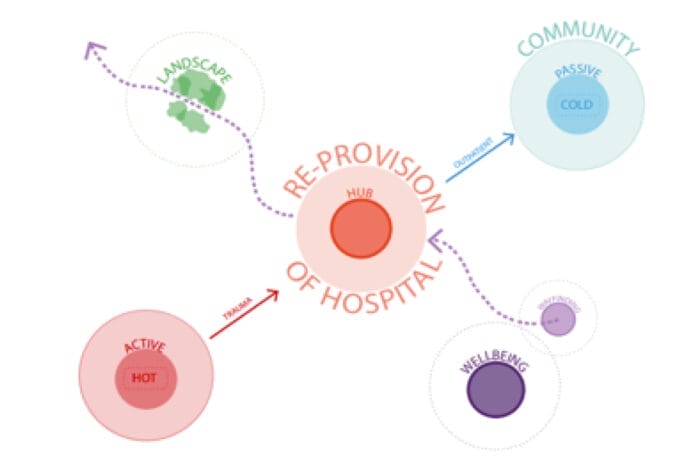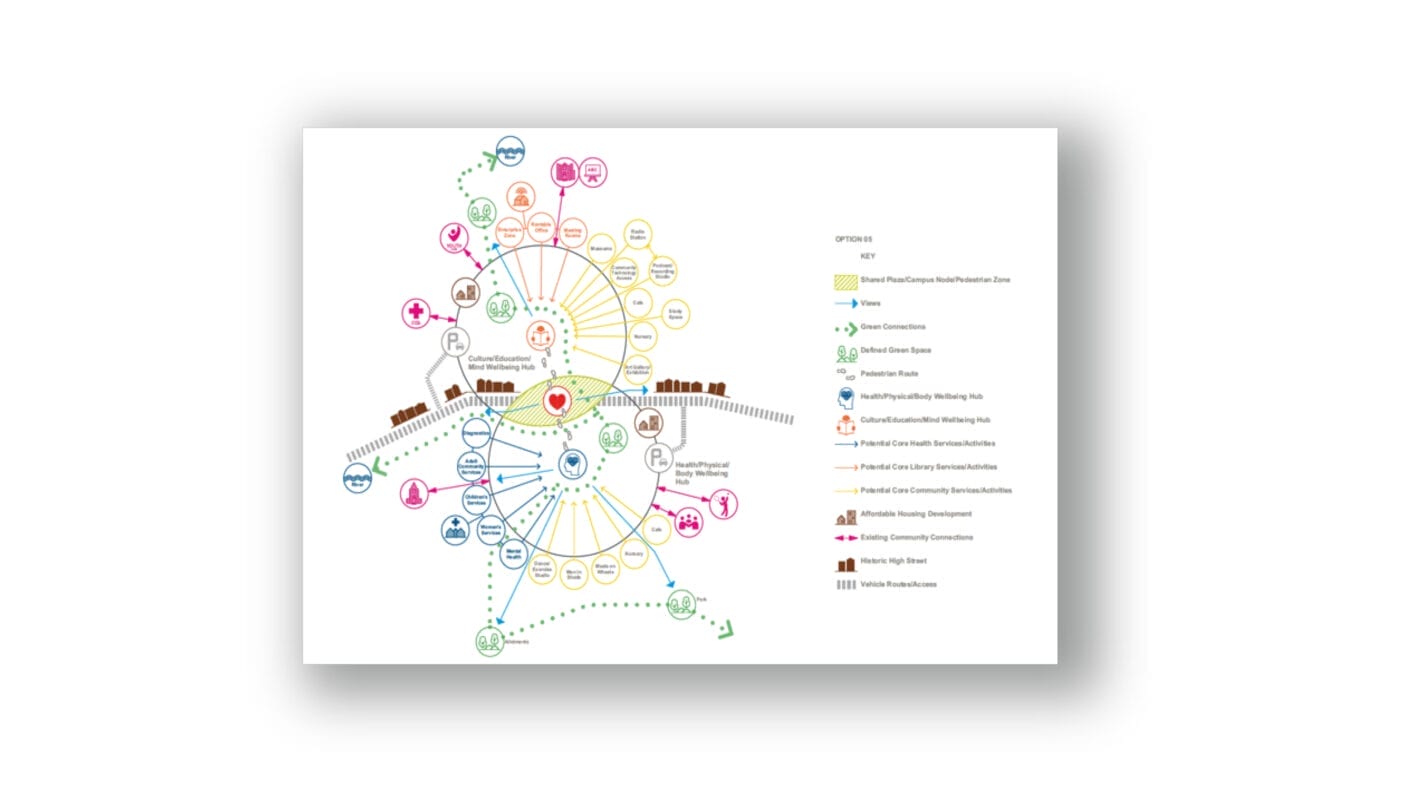
Earlier this month, Associate Director Neil Orpwood joined Jack Wagstaff, Chief Officer of the NHS Surrey Heartlands (NW Surrey Alliance), at the European Healthcare Design Conference, to present their work with Well North Enterprises on integrated health and wellbeing.
Staines is one of six identified national pioneers, with other pilots in Sleaford, Lincolnshire; Hucknall, Nottinghamshire; Plymouth, Devon; Derby, Derbyshire; and Shrewsbury, Shropshire, all at varying stages of development.
The projects, which have been based around North West Surrey with a specific focus on Staines, looked to develop a methodology which could be applied to any community, bringing together organisations that have a direct impact on wider community wellbeing. Critical to the success and sustainability of this system change is collaboration between Acute, Primary and Social Services care, viewed under the umbrella of the newly formed Integrated Care Systems (ICSs) – July 2022.
The team looked to prove that an integrated, collaborative approach has wide-reaching benefits to communities and organisations, both within and outside the NHS.
They presented three steps, which together would equip any community health service to identify their local needs to become a provider of wellness:
- Diagnostic – Identify existing successful organisations and establish – through engagement – what services the individual community needs.
- Immersion – a more traditional, in-person workshop with a small but, crucially, carefully selected group. Facilitated with appropriate plans/maps/data for the wider area but focused on service and activity needs at this stage rather than physical, built environment requirements.
- Mobilisation – provide recommendations on the most productive initiatives with which to start

As you’d expect, the base principles have been developed to suit the site-specific requirements, and allow for opportunities to meet government targets for Modern Methods of Construction and Net Zero Carbon. The masterplan is intended to promote collaboration, mixed-use developments and the role of developers in leading this integration.
Critical for the success of this strategy is a leadership team that are empowered to make decisions and take responsibility.
The work in Surrey has led directly to recommendations to government on the best way forward for our overall health and wellbeing, specifically in the following areas:
- Surrey Integrated Care System promotion as national pathfinder – goal to become a HARP (High Accountability & Responsibility Partnership)
- Fewer central targets – better local autonomy
- Upstream prevention investment
- Data collection (NHS East to share ways of feeding back successes and failures to system)
- See health in terms of value rather than monetary cost
- While the national program has been paused, the outcomes from the programme collaboration (from all 6 of the initial pioneer schemes) and specifically the associated design guide developed by NHS E&I for the programme business case, provide the roadmap for a successful journey to improving our health and wellbeing.
With the support of developers, planning submissions have been made to maintain progress to try and counter the current uncertain construction market, and the impact of a “stop/start” approach can only be detrimental.
Critical for the success though will be a level of strategic vision from the top down. A proper “one public estate” approach: locally led partnerships of public sector bodies collaborating around their service delivery strategies and estate needs, maximising the investment of public resources, and the fact that the Department of Health have to start looking at healthcare provision properly, holistically, and over the long term.

Learning by Doing – St Peter’s Hospital (Ashford & St Peter’s Hospital NHS Trust – ASPH) Case Study
As previously mentioned, this approach has been developed through the work between HLM Architects and Well North Enterprises in and around Staines.
They have been working across North-West Surrey since November 2019, initially supporting Ashford & St Peter’s NHS Trust (ASPH) to better understand the possibilities available on their St Peter’s site, but very quickly becoming more widely involved with the, then newly emerging, NW Surrey Alliance.
Diagnostic
Our initial area research identified a great example of a successful organisation at Woking Lighthouse. In 2011, an empty shop unit, provided by Woking Borough Council, was ‘fitted out’ by volunteers to initially provide a food bank and community space. Connections with the community grew as the food bank provided its lifeline, and through chance discussions and the relationships built, the real needs of the community were identified. In Woking, this specifically comprised: classes teaching single parents techniques for job interviews, smart clothing loans and repairs (for those interviews), a Sunday lunch club, and woodworking skills. A lot of the activities provided the dual benefit of opportunities for some of the more mature volunteers to transfer learned skills, as well relieve their isolation, particularly after lockdown, subtly improving mental health.
Immersion
With the key stakeholders identified, the group worked across two days to provide a clear strategic plan, based on five overarching principles and what locally appropriate activities could then underpin them. At this stage, this specifically revolved around the St Peter’s site, but also required an understanding of the surrounding areas. This led to subsequent visits to over twenty sites, where discussions were had with over 400 people to ‘diagnose’ the needs of the community. This allowed the team to forge connections with not only key potential stakeholders, but also individuals, and encourage relationships that hadn’t previously been obvious.
To capture these opportunities in a live way, a simple online tool, Google My Maps was utilized, allowing the whole team to continue to add initiatives following the workshop, ensuring continual assessment to prioritise as required.
Mobilisation
Recommendations were made to ASPH on the most productive initiatives with which to start on the acute site, but were found to be equally applicable to each of the boroughs. This led to the Integrated Care System strategy, which considered the initiatives in the wider context.
Layers of local need were threaded into the overall delivery plan. For example, the landscape initiative included an opportunity for the very urban feel acute site to deliver focused rest points (a deck in the wooded copse, adjacent to the new entrance multi-storey – providing a chance to take a breath); connections to the surrounding community (land having been sold for housing); and using the surface carpark at weekends for a market square. Crucially, these are all small-scale interventions that provide longer-term, self-funded, sustainable activities.
Related posts



